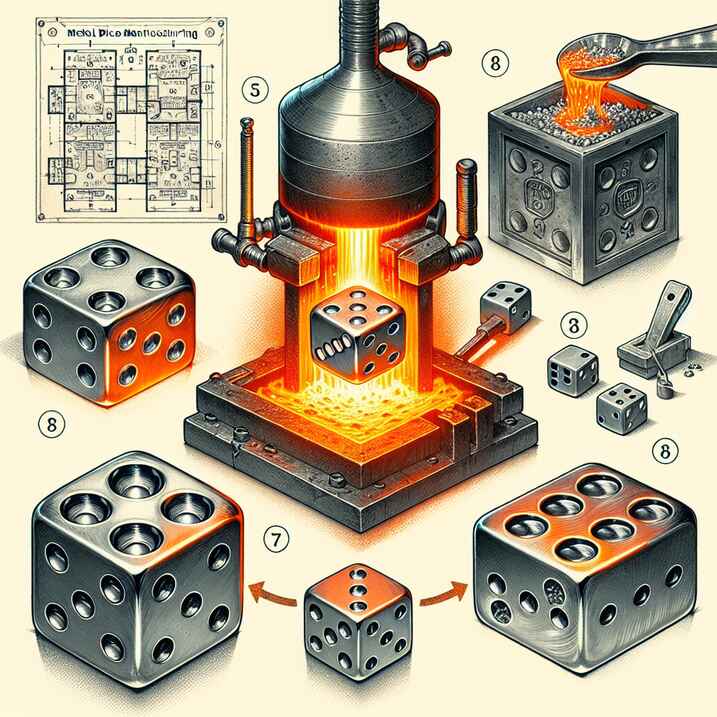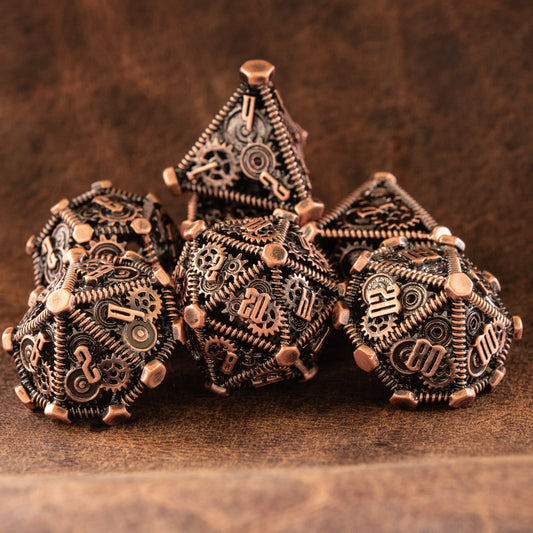
How Are Metal Dice Made: The Craftsmanship Behind the Roll
Share
How Are Metal Dice Made: The Craftsmanship Behind the Roll
Introduction
In the enchanting world of tabletop gaming, few artifacts captivate the imagination quite like metal dice. Their weight, their gleam, and the satisfying clink they make against the table imbue each roll with a sense of gravity and anticipation. But how are these mesmerizing objects created? This article delves into the intricate process of metal dice manufacturing, offering a detailed exploration of the craftsmanship behind each roll. We'll uncover the secrets of mold creation, design intricacies, and the history that has shaped these gaming essentials. So, let's embark on this journey to discover "how are metal dice made" and appreciate the artistry involved.
Creating the Mold
Importance of Molds in Metal Dice Manufacturing
Molds are the unsung heroes in the world of metal dice manufacturing. They are the foundation upon which the entire process is built, ensuring each die is perfectly shaped and balanced. Without precise molds, the dice would lack the uniformity and fairness essential for any game of chance.
Materials and Methods Used to Create Molds
Creating molds for metal dice is a high-precision task, often achieved through CNC (Computer Numerical Control) machining. This method allows for the creation of intricate and detailed molds from materials like steel and aluminum. CNC machining ensures that each mold is identical, which is crucial for maintaining consistency across multiple dice.
Detailed Steps in Mold Creation
- Design Phase: The process begins with a detailed design, usually created using CAD (Computer-Aided Design) software. This design includes all the specifications for the dice, such as size, shape, and numbering.
- Machining: The design is then transferred to a CNC machine, which carves the mold from a solid block of metal. This step requires high precision to ensure that the mold captures every detail of the design.
- Testing: Once the mold is created, it undergoes rigorous testing. Sample dice are cast from the mold and inspected for any imperfections or deviations from the design.
- Adjustments: If any issues are found, adjustments are made to the mold. This may involve further machining or even creating a new mold from scratch.
- Final Approval: After passing all tests, the mold is approved for production. It is now ready to be used for casting metal dice.
Designing Metal Dice
Conceptualization and Design Process
The design of metal dice is where creativity meets precision. Designers often draw inspiration from various sources, including mythology, nature, and modern art. The goal is to create a set of dice that not only function perfectly but also captivate the player's imagination.
Role of CAD in Creating Precise and Intricate Designs
CAD software plays a pivotal role in the design process. It allows designers to create highly detailed and precise models of the dice, which can then be translated into physical molds. CAD ensures that every angle, edge, and number on the dice is meticulously planned and executed.
Customization Options for Metal Dice
Customization is a significant aspect of metal dice design. Players often seek unique sets that reflect their personalities or gaming preferences. Some popular customization options include:
- Engraving: Adding personalized engravings, such as initials or symbols.
- Unique Shapes: Designing dice with unconventional shapes, such as those inspired by fantasy creatures or ancient artifacts.
- Finishes: Applying different finishes, like antique bronze, polished silver, or matte black, to give the dice a distinctive look.
History of Dice
Ancient Origins of Dice in Various Cultures
Dice have a rich history that spans thousands of years and numerous cultures. The earliest dice, dating back to around 3000 BCE, were found in Mesopotamia and were made from materials like bones, ivory, and stone. Ancient civilizations, including the Egyptians, Greeks, and Romans, used dice for both gaming and divination.
Evolution of Materials Used in Dice Making
Over the centuries, the materials used to make dice have evolved significantly. Early dice were often made from natural materials like bones and stones. As technology advanced, so did the materials, with wood, metal, and eventually plastics becoming common. Each material brought its own set of properties, influencing the weight, durability, and aesthetic of the dice.
Introduction of Metal Dice in Gaming History
Metal dice made their debut in the gaming world as a premium alternative to plastic and resin dice. Their durability, heft, and elegance quickly made them a favorite among serious gamers. Metal dice not only enhanced the tactile experience of rolling but also added a touch of sophistication to the gaming table.
Materials Used in Metal Dice
Common Metals Used in Dice Making
Several metals are commonly used in the production of metal dice, each offering unique properties:
- Zinc Alloy: Known for its durability and affordability, zinc alloy is a popular choice for metal dice.
- Brass: Offers a beautiful golden hue and substantial weight, making it a favorite for premium dice sets.
- Copper: Provides a warm, reddish tone and excellent durability, often used for high-end dice.
Explanation of Metal Properties That Make Them Suitable for Dice
The metals used in dice making are chosen for their specific properties:
- Durability: Metals like zinc alloy, brass, and copper are highly durable, ensuring the dice can withstand frequent use without damage.
- Weight: The heft of metal dice adds to the tactile experience, making each roll feel significant.
- Aesthetics: Metals can be polished, engraved, and finished in various ways to create visually stunning dice.
Comparison of Metal Dice to Plastic and Resin Dice
Metal dice stand out from their plastic and resin counterparts in several ways:
- Durability: Metal dice are far more durable, resisting chips and cracks that can plague plastic and resin dice.
- Weight: The added weight of metal dice provides a more satisfying roll and helps prevent accidental rolls off the table.
- Aesthetics: Metal dice offer a level of sophistication and elegance that plastic and resin dice often lack.
In conclusion, the creation of metal dice is a meticulous process that combines ancient techniques with modern technology. From the initial design to the final roll, each step is carefully executed to produce dice that are not only functional but also works of art. So, the next time you roll a metal die, take a moment to appreciate the craftsmanship and history that went into its creation.
How Are Metal Dice Made: The Craftsmanship Behind the Roll
Metal Casting Process
Step-by-Step Explanation of the Metal Casting Process
The heart of metal dice manufacturing lies in the metal casting process. This intricate procedure transforms raw metal into finely crafted dice. Here's a step-by-step breakdown:
- Melting the Metal: The chosen metal, be it zinc alloy, brass, or copper, is heated in a furnace until it reaches a molten state. This requires precise temperature control to ensure the metal melts uniformly.
- Pouring the Metal into Molds: Once the metal is molten, it is carefully poured into the pre-prepared molds. This step demands precision to avoid air bubbles and ensure the metal fills every crevice of the mold.
- Cooling and Solidification: After the molds are filled, they are left to cool. The cooling process allows the metal to solidify, taking the shape of the mold. This step is critical, as uneven cooling can lead to imperfections.
- Demolding: Once the metal has fully solidified, the molds are opened, and the raw metal dice are extracted. These dice are now in their rough form, ready for further refinement.
Ensuring Quality and Precision
Throughout the casting process, quality control measures are in place to ensure each die meets the highest standards. This includes inspecting the molds for wear and tear, monitoring the temperature of the molten metal, and checking the solidified dice for any defects.
Printing and Numbering
Methods for Engraving or Printing Numbers on Metal Dice
Once the dice have been cast and cooled, the next step is to add the numbers. There are several methods to achieve this:
- Laser Engraving: This technique uses a laser to etch the numbers onto the dice. Laser engraving is highly precise and allows for intricate designs.
- Hand Painting: In some cases, the numbers are hand-painted onto the dice. This method, while labor-intensive, adds a personal touch and can be customized with various colors.
- Stamping: Another method involves stamping the numbers into the metal. This technique ensures the numbers are deeply embedded, making them durable and long-lasting.
Comparison of Different Numbering Techniques
- Laser Engraving: Offers precision and durability but can be more expensive.
- Hand Painting: Provides customization and a unique look but may wear off over time.
- Stamping: Ensures longevity and consistency but may lack the finesse of engraving.
Ensuring Readability and Durability of Numbers
Regardless of the method used, ensuring the numbers are readable and durable is paramount. This involves multiple layers of quality control, including visual inspections and testing the dice under various conditions to ensure the numbers remain intact.
Testing and Balancing
Importance of Balanced Dice for Fair Gameplay
Balanced dice are crucial for fair gameplay. An unbalanced die can skew results, leading to an unfair advantage or disadvantage. Ensuring balance involves meticulous testing and adjustments.
Techniques Used to Test and Ensure Balance
- Rolling Tests: Dice are rolled multiple times to check for any biases. This statistical analysis helps identify any imbalances.
- Weight Distribution Analysis: Advanced techniques, such as X-ray scanning, are used to analyze the internal structure of the dice and ensure even weight distribution.
Adjustments Made to Achieve Perfect Balance
If any imbalances are detected, adjustments are made. This may involve adding or removing material from the dice or even recasting them. The goal is to achieve perfect balance, ensuring each roll is fair and random.
Finishing Touches
Cleaning and Polishing Metal Dice to Remove Imperfections
After casting, numbering, and balancing, the dice undergo a series of finishing touches. This begins with cleaning and polishing to remove any imperfections and enhance their aesthetic appeal.
Techniques for Adding Color, Patina, or Other Finishes
- Electroplating: This process adds a thin layer of metal, such as gold or silver, to the dice, giving them a luxurious finish.
- Patina Application: Patinas can be applied to give the dice an aged or antique look, adding character and uniqueness.
- Coloring: Various techniques, including anodizing and painting, are used to add vibrant colors to the dice.
Quality Control Measures to Ensure Precision and Fairness
Throughout the finishing process, quality control remains a priority. Each die is inspected for any defects, ensuring they meet the highest standards of precision and fairness.
The journey of creating metal dice is a testament to the fusion of ancient craftsmanship and modern technology. From the initial design to the final polish, each step is meticulously executed to produce dice that are not only functional but also works of art. The craftsmanship, precision, and passion that go into making metal dice are truly remarkable.
So, the next time you roll a metal die during your tabletop adventures, take a moment to appreciate the artistry and dedication behind its creation. Share this article, leave your comments, and explore more about the fascinating world of metal dice. Whether you're a seasoned gamer or a curious enthusiast, there's always something new to discover in the realm of tabletop gaming.
Call-to-Action: If you enjoyed this deep dive into the world of metal dice, don't forget to share it with your fellow gamers. Leave a comment below with your thoughts or questions, and explore our other articles for more insights into the enchanting world of tabletop gaming. Happy rolling!


